研究生综合英语课文.Unit 8.The Business as a Hunting Ground
- 格式:doc
- 大小:30.50 KB
- 文档页数:4
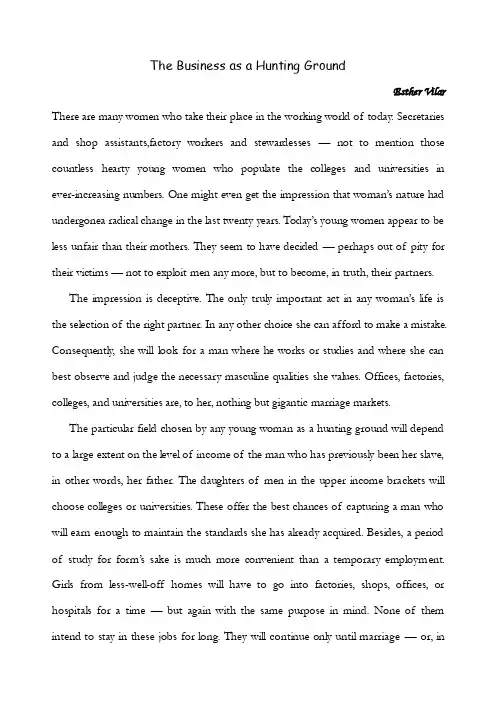
The Business as a Hunting GroundEsther Vilar There are many women who take their place in the working world of today. Secretaries and shop assistants,factory workers and stewardesses —not to mention those countless hearty young women who populate the colleges and universities in ever-increasing numbers. One might even get the impression that woman’s nature had undergonea radical change in the last twenty years. Today’s young women appear to be less unfair than their mothers. They seem to have decided — perhaps out of pity for their victims — not to exploit men any more, but to become, in truth, their partners.The impression is deceptive. The only truly important act in any woman’s life is the selection of the right partner. In any other choice she can afford to make a mistake. Consequently, she will look for a man where he works or studies and where she can best observe and judge the necessary masculine qualities she values. Offices, factories, colleges, and universities are, to her, nothing but gigantic marriage markets.The particular field chosen by any young woman as a hunting ground will depend to a large extent on the level of income of the man who has previously been her slave, in other words, her father. The daughters of men in the upper income brackets will choose colleges or universities. These offer the best chances of capturing a man who will earn enough to maintain the standards she has already acquired. Besides, a period of study for form’s sake is much more convenient than a temporary employm ent. Girls from less-well-off homes will have to go into factories, shops, offices, or hospitals for a time — but again with the same purpose in mind. None of them intend to stay in these jobs for long. They will continue only until marriage — or, incases of hardship, till pregnancy. This offers woman one important advantage, any woman who marries nowadays has given up her studies or her job “for the sake of the man of her choice” —and “sacrifices” of this nature create obligations.Therefore, when women work and study, it merely serves to falsify statistics and furthermore to enslave men more hopelessly than ever, because education and the professions mean something very different when applied to women as opposed to men.When a man works it is a matter of life and death, and, as a rule, the first years of his life are decisive. Any man of twenty-five who is not well on his way up the ladder can beconsidered, to all intents and purposes, a hopeless case. At this stage, all his faculties are being developed, and the fight with his competitors is a fight to the death. Behind a mask of business friendship, he is constantly on the watch for anysign of superiority in one of his associates, and he will note its appearance with anxiety. If this same associate shows signs of weakness or indecision, it must be taken advantage of at once. Yet man is only a tiny cog in a gigantic business machine, he himself being in effect exploited at every turn.When he drives others, he drives himself most of all. His orders are really orders from above, passed on by him. If the men at the top occasionally take time to praise him, it is not in order tomake him happy; it is only to spur him on, to stimulate him to greater effort. For man, who was brought up to be proud and honorable, every working day is merely an endless series of humiliations. He shows enthusiasm for products he finds useless, he laughs at jokes he finds tasteless, he expresses opinions which are not his own.Not for a moment is he allowed to forget that the merest oversight may meandemotion, that one slip of the tongue may spell the end of his career.Yet woman, who is the prime cause of all these struggles, and under whose very eyes these fights take place, just stands aside and watches. Going to work means to her flirting and dates, teasing and banter, with the odd bit of “labor” done for the sake of appearances — work for which, as a rule, she has no responsibility. She knows that she is only marking time, and even if she does have to go on working for one reason or another, at least she has had years of pleasant dreams. She watches men's battles from a safe distance, occasionally applauding one of the contestants, encouraging or scolding, and while she makes their coffee, opens their mail, or listens to their telephone conversations, she is cold-bloodedly taking her pick. The moment she has found “Mr. Right,” she retires gracefully, leaving the field open to her successor.The same applies to university education. American colleges admit more and more women, but the percentage who actually complete their courses is less than before the SecondW orld War. They sit happily in lectures designing their spring wardrobe and between classes flirt with the boys. With their scarlet nails carefully protected by transparent rubber gloves, they play around with corpses in the dissecting rooms, while their male colleagues realize their whole future is at stake. If a woman leaves the university with an engagement ring on her finger, she has earned her degree; man has hardly begun when he obtains his diploma. Degrees are, after all, easy to come by —you have only to memorize. How many examiners can tell the difference between real knowledge and bluff? Man, however, has to understand his subject as well. His later success will depend on whether his knowledge is well-founded; his later prestige will be built on this, and often other people’s lives are dependent on it.None of these battles exists for woman.If she breaks off her studies and marries a university lecturer, she has achieved the same level as he has without exerting herself. As the wife of a factory owner she is treated with greater respect than he is (and not as somebody who at best would be employable on the assembly line in the same factory). As a wife she always has the same standard of living and social prestige and has to do nothing to maintain them — as he does. For this reason the quickest way to succeed is always to marry a successful man. She does not win him by her industry, ambition, or perseverance —but simply through an attractive appearance.We have already seen what demands the well-trained man makes on a woman’s appearance. The best women trainers — without the least effort — catch the most successful fighters among men. The so-called “beautiful” women are usually those who have had an easy life from their childhood days and therefore have less reason than others to develop their intellectual gifts (intelligence is developed only through competition); it follows as a logical consequence that very successful men usually have abysmally stupid wives ( unless, of course, one considers woman’s skill at transforming herself into bait for man a feat of intelligence). It has almost become a commonplace that a really successful man, be he a company director, financier, shipping magnate, or orchestra conductor, will, when he reaches the zenith of his career, marry a beautiful model usually his second or third wife. Men who have inherited money often take such a supergirl as their first wife although she will be exchanged over the years for another. Yet, as a rule, models are women of little education who have not even finished school and who have nothing to do until they marry but look beautiful and pose becomingly in front of a camera. But they are “beautiful” —and that makes them potentiallyrich.A small percentage (ten to twenty percent) of women students in industrial countries of the West do, in fact, obtain their degrees before they get married. Despite occasionalexceptions, they are, as a rule, less attractive and have failed to catch a suitable provider while still in school. But then, this degree will automatically raise their market value, for there are certain types of men who feel bolstered if their wife has a degree —providing they have one themselves. It is clear evidence of his own cleverness if such a highly educated woman is interested in him. If by chance this female mastermind happens to be sexy, he will be beside himself with joy.But not for long. Even women doctors, women sociologists, and women lawyers “sacrifice” their careers for their men, or at least set them aside. They withdraw into suburban ranch houses, have children, plant flower beds and fill their homes with the usual trash. Within a few years these new entertainments obliterate the small amount of “expert knowledge,” learned by rote, of course, and they become exactly like their female neighbors.。
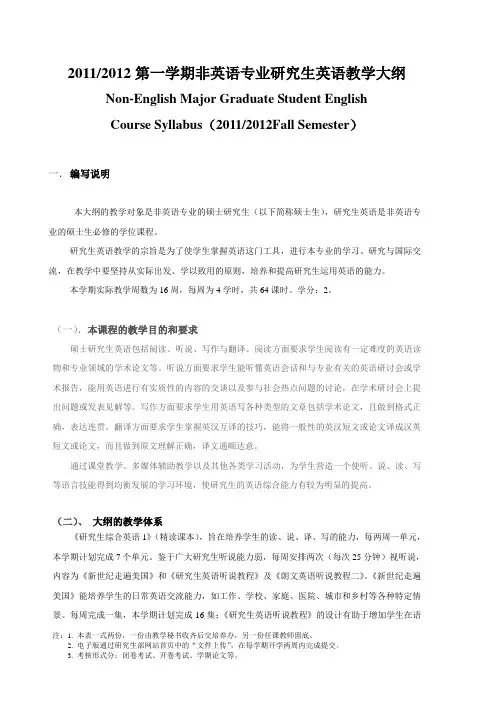
2011/2012第一学期非英语专业研究生英语教学大纲Non-English Major Graduate Student EnglishCourse Syllabus(2011/2012Fall Semester)一.编写说明本大纲的教学对象是非英语专业的硕士研究生(以下简称硕士生),研究生英语是非英语专业的硕士生必修的学位课程。
研究生英语教学的宗旨是为了使学生掌握英语这门工具,进行本专业的学习、研究与国际交流,在教学中要坚持从实际出发、学以致用的原则,培养和提高研究生运用英语的能力。
本学期实际教学周数为16周,每周为4学时,共64课时。
学分:2。
(一).本课程的教学目的和要求硕士研究生英语包括阅读、听说、写作与翻译。
阅读方面要求学生阅读有一定难度的英语读物和专业领域的学术论文等。
听说方面要求学生能听懂英语会话和与专业有关的英语研讨会或学术报告,能用英语进行有实质性的内容的交谈以及参与社会热点问题的讨论,在学术研讨会上提出问题或发表见解等。
写作方面要求学生用英语写各种类型的文章包括学术论文,且做到格式正确,表达连贯。
翻译方面要求学生掌握英汉互译的技巧,能将一般性的英汉短文或论文译成汉英短文或论文,而且做到原文理解正确,译文通顺达意。
通过课堂教学、多媒体辅助教学以及其他各类学习活动,为学生营造一个使听、说、读、写等语言技能得到均衡发展的学习环境,使研究生的英语综合能力有较为明显的提高。
(二)、大纲的教学体系《研究生综合英语1》(精读课本),旨在培养学生的读、说、译、写的能力,每两周一单元,本学期计划完成7个单元。
鉴于广大研究生听说能力弱,每周安排两次(每次25分钟)视听说,内容为《新世纪走遍美国》和《研究生英语听说教程》及《朗文英语听说教程二》。
《新世纪走遍美国》能培养学生的日常英语交流能力,如工作、学校、家庭、医院、城市和乡村等各种特定情景。
每周完成一集,本学期计划完成16集;《研究生英语听说教程》的设计有助于增加学生在语篇层次上的听说能力,提高他们对所听材料的分析判断和归纳总结能力,以及用英语就一般性话题和专业话题表达观点的能力。
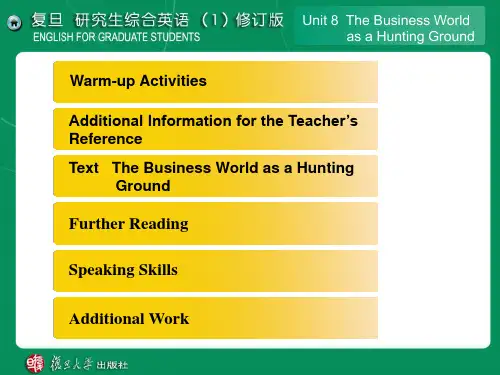
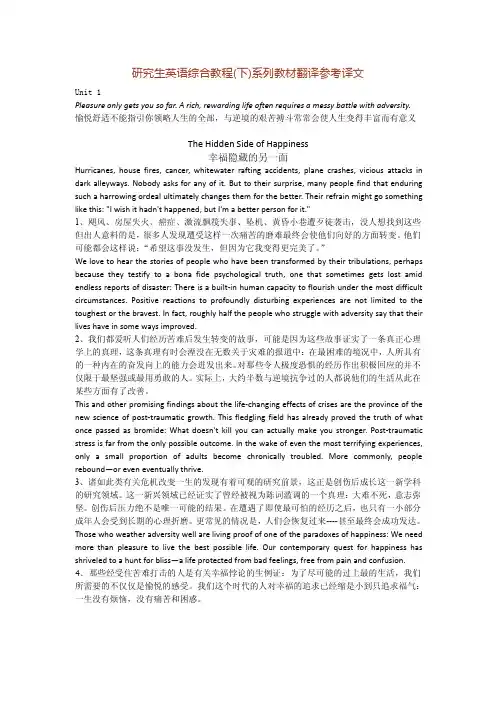
研究生英语综合教程(下)系列教材翻译参考译文Unit1Pleasure only gets you so far.A rich,rewarding life often requires a messy battle with adversity.愉悦舒适不能指引你领略人生的全部,与逆境的艰苦搏斗常常会使人生变得丰富而有意义The Hidden Side of Happiness幸福隐藏的另一面Hurricanes,house fires,cancer,whitewater rafting accidents,plane crashes,vicious attacks in dark alleyways.Nobody asks for any of it.But to their surprise,many people find that enduring such a harrowing ordeal ultimately changes them for the better.Their refrain might go something like this:"I wish it hadn't happened,but I'm a better person for it."1、飓风、房屋失火、癌症、激流飘筏失事、坠机、黄昏小巷遭歹徒袭击,没人想找到这些但出人意料的是,很多人发现遭受这样一次痛苦的磨难最终会使他们向好的方面转变。
他们可能都会这样说:“希望这事没发生,但因为它我变得更完美了。
”We love to hear the stories of people who have been transformed by their tribulations,perhaps because they testify to a bona fide psychological truth,one that sometimes gets lost amid endless reports of disaster:There is a built-in human capacity to flourish under the most difficult circumstances.Positive reactions to profoundly disturbing experiences are not limited to the toughest or the bravest.In fact,roughly half the people who struggle with adversity say that their lives have in some ways improved.2、我们都爱听人们经历苦难后发生转变的故事,可能是因为这些故事证实了一条真正心理学上的真理,这条真理有时会湮没在无数关于灾难的报道中:在最困难的境况中,人所具有的一种内在的奋发向上的能力会迸发出来。

Unit Eight It's almost a common sense that wearing a seat belt can keep passengers from being injured or being killed in a car accident. But recent research done by John Adams shows more complicated statistics. More car accidents are caused by the reckless drivers who wear seat belts.THE HIDDEN DANGER OF SEAT BELTS David Bjerklie1 Seat belts still decrease our risk of dying in an accident, but the statistics are not all black and white. In fact, according to one researcher, seat belts may actually cause people to drive more recklessly.2 If there's one thing we know about our risky world, it's that seat belts save lives. And they do, of course. But reality, as usual, is messier and more complicated than that. John Adams, risk expert and emeritus professor of geography at University College London, was an early skeptic of the seat belt safety mantra. Adams first began to look at the numbers more than 25 years ago. What he found was that contrary to conventional wisdom, mandating the use of seat belts in 18 countries resulted in either no change or actually a net increase in road accident deaths.3 How can that be? Adams' interpretation of the data rests on the notion of risk compensation, the idea that individuals tend to adjust their behavior in response to what they perceive; as changes in the level of risk. Imagine, explains Adams, a driver negotiating a curve in the road. Let's make him a young male. He is going to be influenced by his perceptions of both the risks and rewards of driving a car. The considerations could include getting to work or meeting a mend for dinner on time, impressing a companion with his driving skills, bolstering his image of himself as an accomplished driver. They could also include his concern for his own safety and desire to live to a ripe old age, his feelings of responsibility for a toddler with him in a car seat, the cost of banging up his shiny new car or losing his license.Nor will these possible concerns exist in a vacuum. He will be taking into account the weather and the condition of the road, the amount of traffic and the capabilities of the car he is driving. But crucially, says Adams, this driver will also be adjusting his behavior in response to what he perceives are changes in risks. If he is wearing a seat belt and his car has front and side air bags and anti-skid brakes to boot, he may in turn drive a bit more daringly.4 The point, stresses Adams, is that drivers who feel safe may actually increase the risk that they pose to other drivers, bicyclists, pedestrians and their own passengers (while an average of 80% of drivers buckle up, only 68% of their rear-seat passengers do). And risk compensation is hardly confined to the act of driving a car. Think of a trapeze artist, suggests Adams, or a rock climber or motorcyclist. Add some safety equipment to the equation- a net, rope or helmet respectively- and the person may try maneuvers that he or she would otherwise consider foolish. In the case of seat belts, instead of a simple, straightforward reduction in deaths, the end result is actually a more complicated redistribution of risk and fatalities. For the sake of argument, offers Adams, imagine how it might affect the behavior of drivers if a sharp stake were mounted in the middle of the steering wheel? Or if the bumper were packed with explosives. Perverse, yes, but it certainly provides a vivid example of how a perception of risk could modify behavior.5 In everyday life, risk is a moving target, not a set number as statistics might suggest. In addition to external factors, each individual has his or her own internal comfort level with risk- taking. Some are daring while others are cautious by nature. And still others are fatalists who may believe that a higher power devises mortality schedules that fix a predetermined time when ournumber is up. Consequently, any single measurement assigned to the risk of driving a car is bound to be only the roughest sort of benchmark. Adams cites, as an example the statistical fact that a young man is 100 times more likely to be involved in a severe crash than is a middle-aged woman. Similarly, someone driving at 3:00 a.m. Sunday is more than 100 times more likely to die than someone driving at 10:00 a.m. Sunday. Someone with a personality disorder is 10 times more likely to die. And let's say he's also drunk. Tally up All these factors and consider them independently says Adams, and you could arrive at. a statistical prediction that a disturbed, drunken young man driving in the middle of the night is 2.7 million times more likely to be involved in a serious accident than would a sober, middle-aged woman driving to church seven hours later.6 The bottom line is that risk doesn't exist in a vacuum and that there are a host of factors that come into play, including the rewards of risk, whether they are financial, physical or emotional. It is this very human context which risk exists. That is key, says Adams, who titled one of his recent blogs: What Kills You Matters- Not Numbers. Our reaction to risk very much depends on the degree to which it is voluntary (scuba diving), unavoidable (public transit) or imposed (air quality), the degree to which we feel we are in control (driving) or at the mercy of others (plane travel), and the degree to which the source of possible danger is benign ("doctor's orders), indifferent (nature) or malign, (murder and terrorism). We make dozens of risk calculations daily, but you can book odds- that most of them are so automatic or visceral- that we barely notice them.。

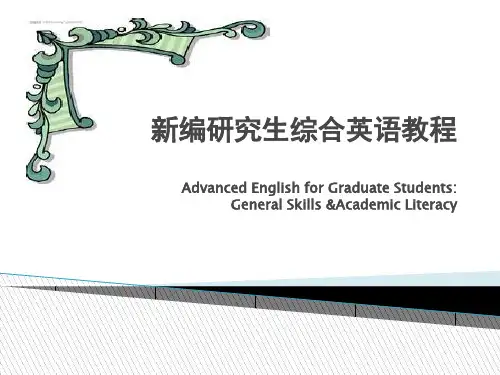

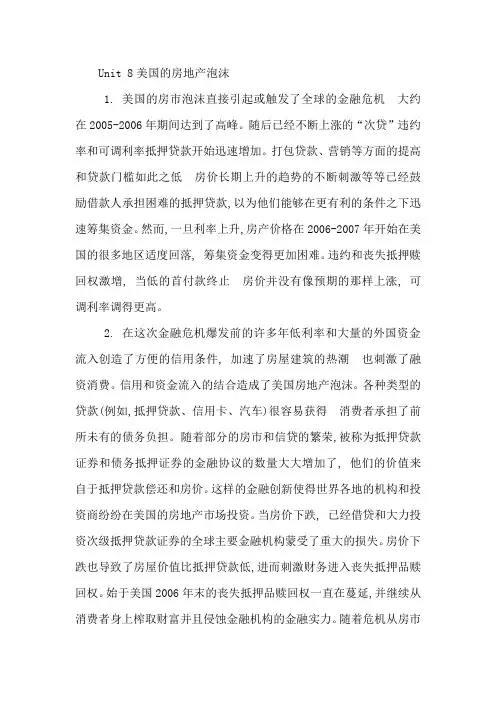
Unit 8美国的房地产泡沫1.在2005-2006年期间达到了高峰。
随后已经不断上涨的“次贷”违约率和可调利率抵押贷款开始迅速增加。
打包贷款、营销等方面的提高励借款人承担困难的抵押贷款,以为他们能够在更有利的条件之下迅速筹集资金。
然而,一旦利率上升,房产价格在2006-2007年开始在美国的很多地区适度回落, 筹集资金变得更加困难。
违约和丧失抵押赎回权激增, 的那样上涨, 可调利率调得更高。
2. 在这次金融危机爆发前的许多年低利率和大量的外国资金流入创造了方便的信用条件,资消费。
信用和资金流入的结合造成了美国房地产泡沫。
各种类型的贷款(例如,抵押贷款、信用卡、汽车)所未有的债务负担。
随着部分的房市和信贷的繁荣,被称为抵押贷款证券和债务抵押证券的金融协议的数量大大增加了, 他们的价值来自于抵押贷款偿还和房价。
这样的金融创新使得世界各地的机构和投资商纷纷在美国的房地产市场投资。
当房价下跌, 已经借贷和大力投资次级抵押贷款证券的全球主要金融机构蒙受了重大的损失。
房价下跌也导致了房屋价值比抵押贷款低,进而刺激财务进入丧失抵押品赎回权。
始于美国2006年末的丧失抵押品赎回权一直在蔓延,并继续从消费者身上榨取财富并且侵蚀金融机构的金融实力。
随着危机从房市球的损失总额估计在数万亿美元。
3. 当房市泡沫和信贷泡沫加剧,一系列的因素导致金融体系不断的扩展,而且变得越来越脆弱,其过程被称为金融体系化。
政策制定者们没有看到如投资银行、对冲基金,也称为影子银行系统的金融机构所扮演的越来越重要的角色。
有些专家认为这些机构为美国经济提供信贷,同样规则的约束。
这些机构以及某些规范银行也承担了大量的债务负抵押贷款证券损失的财务储蓄。
这些损失冲击了金融机构的贷款能力,减缓了经济发展。
对金融机构的稳定性的关注使得中央银行提供资金鼓励借贷和恢复商业票据市场的信心,这对商业运作提供资金至关重要。
政府也帮助金融机构摆脱困境和执行经济刺激计划, 承担额外的财政承诺。
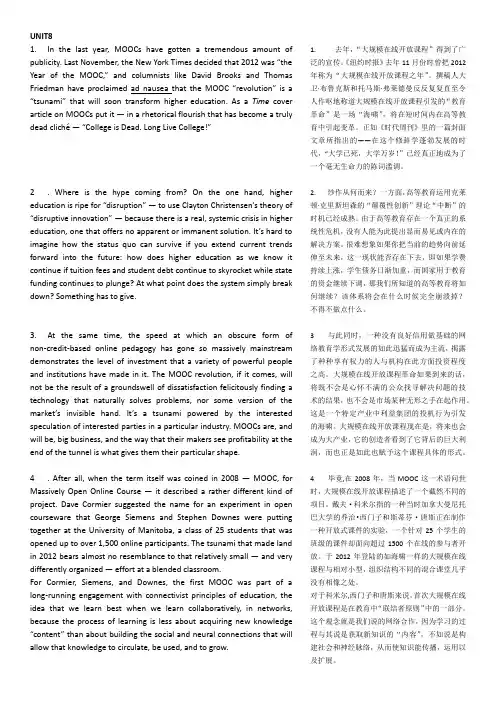
UNIT81. In the last year, MOOCs have gotten a tremendous amount of publicity. Last November, the New York Times decided that 2012 was “the Year of the MOOC,” and columnists like David Brooks and Thomas Friedman have proclaimed ad nausea that the MOOC “revolution” is a “tsunami” that will soon transform higher education. As a Time cover article on MOOCs put it — in a rhetorical flourish that has become a truly dead cliché — “College is Dead. Long Live College!”2. Where is the hype coming from? On the one hand, higher education is ripe for “disruption” — to use Clayton Christensen’s theory of “disruptive innovation” — because there is a real, systemic crisis in higher education, one that offers no apparent or immanent solution. It’s hard to imagine how the status quo can survive if you extend current trends forward into the future: how does higher education as we know it continue if tuition fees and student debt continue to skyrocket while state funding continues to plunge? At what point does the system simply break down? Something has to give.3.At the same time, the speed at which an obscure form of non-credit-based online pedagogy has gone so massively mainstream demonstrates the level of investment that a variety of powerful people and institutions have made in it. The MOOC revolution, if it comes, will not be the result of a groundswell of dissatisfaction felicitously finding a technology that naturally solves problems, nor some version of the market’s invisible hand. It’s a tsunami powered by the interested speculation of interested parties in a particular industry. MOOCs are, and will be, big business, and the way that their makers see profitability at the end of the tunnel is what gives them their particular shape.4. After all, when the term itself was coined in 2008 — MOOC, for Massively Open Online Course — it described a rather different kind of project. Dave Cormier suggested the name for an experiment in open courseware that George Siemens and Stephen Downes were putting together at the University of Manitoba, a class of 25 students that was opened up to over 1,500 online participants. The tsunami that made land in 2012 bears almost no resemblance to that relatively small — and very differently organized — effort at a blended classroom.For Cormier, Siemens, and Downes, the first MOOC was part of a long-running engagement with connectivist principles of education, the idea that we learn best when we learn collaboratively, in networks, because the process of learning is less about acquiring new knowledge “content” than about building the social and neural connections that will 1. 去年,“大规模在线开放课程”得到了广泛的宣传。

上unit1——TRAITS OF THE KEY PLAYERS关键员工的特征1.What exactly is a key player?A“Key Player"is aphrase that I've heard about from employers during just about every search I've conducted.I asked a client——a hiring manager involved in a recent search—to define it for me."Every company has a handful of staff in a given area of expertise that you can count on to get the job done.On my team of seven process engineers and biologists,I've got two or three whom I just couldn't live without,”he said."Key players are essential to my organization.And when we hire your company to recruit for us,we expect that you'll be going into other companies and finding just that:the staff that another manager will not want to see leave.We recruit only key players.”关键员工到底是什么?在我进行的每一次搜索中,我都会从雇主那里听到“关键员工”这个词。
UNIt 8,task 3.Risk compensation is the idea that individuals tend to adjust their behavior in response to what they perceive as changes in the level of risk. 风险补偿是指个体倾向于根据他们所认为的风险水平的变化来调整自己的行为。
Imagine,what would happen if safety regulations were to require all cars to be made of cardboard,fitted with inefficient brakes and with a sharp spike in the center of the steering column。
想象一下,如果安全法规要求所有的汽车都是用纸板做的,装有低效的刹车,并且在转向柱的中心有一个尖锐的尖刺,会发生什么。
if all roads were paved with a substance having the same frictiong cofficient as ice ,and if all drivers were obliged to change every other month or ,better yet,if there were no rules about which of the road to drive on.如果所有道路都铺设了与冰相同摩擦系数的物质,如果所有驾驶员必须每隔一个月换一次车,或者,更好的是,如果没有关于在哪条道路上行驶的规定。
the evidence suggests that there would be no increase,and possibly a decrease,in road accident fatalities,but there would be a substantial decrease in the efficiency of the road transport system.有证据表明,道路交通事故死亡人数不会增加,甚至可能会减少,但道路运输系统的效率会大幅下降。
Unit 1 The Hidden Side of Happin ess1 Hurric anes, housefires, cancer, whitew aterraftin g accide nts, planecrashe s, viciou s attack s in dark alleyw ays. Nobody asks for any of it. But to theirsurpri se, many people find that enduri ng such a harrow ing ordeal ultima telychange s them for the better. Theirrefrai n mightgo someth ing like this: "I wish it hadn't happen ed, but I'm a better person for it."1飓风、房屋失火、癌症、激流漂筏失事、坠机、昏暗小巷遭歹徒袭击,没人想找上这些事儿。
但出人意料的是,很多人发现遭受这样一次痛苦的磨难最终会使他们向好的方面转变。
他们可能都会这样说:“我希望这事没发生,但因为它我变得更完美了。
”2 We love to hear the storie s of people who have been transf ormed by theirtribul ation s, perhap s becaus e they testif y to a bona fide type of psycho logic al truth, one that someti mes gets lost amid endles s report s of disast er: Thereseemsto be a built-in humancapaci ty to flouri sh underthe most diffic ult circum stanc es. Positi ve respon ses to profou ndlydistur bingexperi ences are not limite d to the toughe st or the braves t .In fact, roughl y half the people who strugg le with advers ity say that theirlivessubseq uentl y in some ways improv ed.2我们都爱听人们经历苦难后发生转变的故事,可能是因为这些故事证实了一条真正的心理学上的真理,这条真理有时会湮没在无数关于灾难的报道中:在最困难的境况中,人所具有的一种内在的奋发向上的能力会进发出来。
《研究生英语综合教程上》1-6单元练习参考答案Unit One Planning Your Future CareerReading Focus Traits of the Key PlayersText ExplorationTask 2 1. B 2. A 3. D 4. B 5. D 6. B 7. C 8. B 9. B 10. BVocabulary in ActionTask 1 1. A 2. C 3. B 4. C 5. D 6. D 7. D 8. C 9. A 10. D 11. A 12. B Task 2 1. public (c) 2. discipline (b)3. strength (a)4. reference (a)5. strength (d)6. public (a)7. demonstrated (b) 8. discipline (c)9. reference (c) 10. personality (a)11. disciplining (d) 12. demonstrates (a)13. public (d) 14. reference (b)15. personality (c)Task 3 1. employment 2. paid 3. adjust4. setting5. discouraged6. credit7. cite 8. demonstrate 9. teamwork 10. rulesTranslation PracticeParagraph One“一年365天,一周7天,一天24小时,生意始终在进行。
这意味着一年365天,一周7天,一天24小时,竞争也同样在进行。
”豪特说,“公司取胜的方法之一,就是要更快到达‘目的地’!这就是说,你不仅要把所有能支持公司快速运转的功能都调动起来,而且还得知道如何决定‘目的地’是哪里。
这样,不仅对那些行动快速的人们,也对那些思维敏捷并有勇气按自己的想法行事的人们都提出了要求。
英语综合教程4unit8Unit 8: The Business WorldIntroductionThe business world is a complex and dynamic environment that plays a crucial role in the global economy. In this unit, we will explore various aspects of the business world, including different types of businesses, entrepreneurship, and the importance of corporate social responsibility. Additionally, we will examine the role of leadership and management in organizations, as well as the challenges and opportunities presented by globalization.Types of BusinessesThere are various types of businesses, each with its own characteristics and objectives. Sole proprietorships, partnerships, and corporations are the three main legal forms that businesses can take. Sole proprietorships are owned and operated by a single individual, while partnerships involve two or more people who share ownership and responsibility. Corporations, on the other hand, are separate legal entities that are owned by shareholders.EntrepreneurshipEntrepreneurship is the process of starting a new business venture. Entrepreneurs play a vital role in the economy by creating jobs and driving innovation. They are known for their ability to identify opportunities, take risks, and turn their ideas into successful businesses. However, entrepreneurship also comes with its ownchallenges, such as securing funding and managing resources effectively.Corporate Social ResponsibilityCorporate social responsibility (CSR) refers to the ethical practices and responsibilities that companies have towards society and the environment. It involves actions such as minimizing environmental impact, promoting fair labor practices, and giving back to local communities. CSR is becoming increasingly important as consumers and stakeholders demand more transparency and accountability from businesses.Leadership and ManagementEffective leadership and management are crucial for the success of any organization. Leadership involves inspiring and motivating employees to achieve the organization's goals, while management focuses on planning, organizing, and controlling resources to ensure efficient operations. Good leaders possess qualities such as vision, communication skills, and the ability to adapt to change.Challenges and Opportunities of GlobalizationGlobalization has created both opportunities and challenges for businesses. It has opened up new markets and enabled companies to expand their operations internationally. However, globalization also brings increased competition, cultural differences, and the need for organizations to adapt to different legal and regulatory frameworks. Businesses need to be agile and innovative to thrivein the global marketplace.In conclusion, the business world is a diverse and dynamic landscape that encompasses a wide range of activities and challenges. Understanding the different types of businesses, the role of entrepreneurship, and the importance of corporate social responsibility are essential for anyone aspiring to be successful in the business world. Additionally, effective leadership and management, as well as the ability to navigate the challenges and opportunities of globalization, are critical for organizations to thrive in today's global economy. By staying informed and continuously adapting to change, businesses can position themselves for success in this ever-evolving landscape.。
The Business as a Hunting GroundEsther Vilar There are many women who take their place in the working world of today. Secretaries and shop assistants,factory workers and stewardesses —not to mention those countless hearty young women who populate the colleges and universities in ever-increasing numbers. One might even get the impression that woman’s nature had undergonea radical change in the last twenty years. Today’s young women appear to be less unfair than their mothers. They seem to have decided — perhaps out of pity for their victims — not to exploit men any more, but to bee, in truth, their partners.The impression is deceptive. The only truly important act in any woman’s life is the selection of the right partner. In any other choice she can afford to make a mistake. Consequently, she will look for a man where he works or studies and where she can best observe and judge the necessary masculine qualities she values. Offices, factories, colleges, and universities are, to her, nothing but gigantic marriage markets.The particular field chosen by any young woman as a hunting ground will depend to a large extent on the level of ine of the man who has previously been her slave, in other words, her father. The daughters of men in the upper ine brackets will choose colleges or universities. These offer the best chances of capturing a man who will earn enough to maintain the standards she has already acquired. Besides, a period of study for form’s sake is much more convenient than a temporary employment. Girls from less-well-off homes will have to go into factories, shops, offices, or hospitals for a time — but again with the same purpose in mind. None of them intend to stay in these jobs for long. They will continue only until marriage — or, in cases of hardship, till pregnancy. This offers woman one important advantage, any woman who marries nowadays has given up her studies or her job “for the sake of the man of her choice”— and “sacrifices” of this nature create obligations.Therefore, when women work and study, it merely serves to falsify statistics and furthermore to enslave men more hopelessly than ever, because education and the professions mean something very different when applied to women as opposed to men.When a man works it is a matter of life and death, and, as a rule, the first years of his life are decisive. Any man of twenty-five who is not well on his way up the ladder can beconsidered, to all intentsand purposes, a hopeless case. At this stage, all his faculties are being developed, and the fight with his petitors is a fight to the death. Behind a mask of business friendship, he is constantly on the watch for anysign of superiority in one of his associates, and he will note its appearance with anxiety. If this same associate shows signs of weakness or indecision, it must be taken advantage of at once. Yet man is only a tiny cog in a gigantic business machine, he himself being in effect exploited at every turn.When he drives others, he drives himself most of all. His orders are really orders from above, passed on by him. If the men at the top occasionally take time to praise him, it is not in order tomake him happy; it is only to spur him on, to stimulate him to greater effort. For man, who was brought up to be proud and honorable, every working day is merely an endless series of humiliations. He shows enthusiasm for products he finds useless, he laughs at jokes he finds tasteless, he expresses opinions which are not his own.Not for a moment is he allowed to forget that the merest oversight may mean demotion, that one slip of the tongue may spell the end of his career.Yet woman, who is the prime cause of all these struggles, and under whose very eyes these fights take place, just stands aside and watches. Going to work means to her flirting and dates, teasing and banter, with the odd bit of “labor” done for the sake of appearances — work for which, as a rule, she has no responsibility. She knows that she is only marking time, and even if she does have to go on working for one reason or another, at least she has had years of pleasant dreams. She watches men's battles from a safe distance, occasionally applauding one of the contestants, encouraging or scolding, and while she makes their coffee, opens their mail, or listens to their telephone conversations, she is cold-bloodedly taking her pick. The moment she has found “Mr. Right,”she retires gracefully, leaving the field open to her successor.The same applies to university education. American colleges admit more and more women, but the percentage who actually plete their courses is less than before the SecondWorld War. They sit happily in lectures designing their spring wardrobe and between classes flirt with the boys. With their scarlet nails carefully protected by transparent rubber gloves, they play around with corpses in the dissecting rooms, while their male colleagues realize their whole future is at stake. If a woman leaves the university with an engagement ring on her finger, she has earned her degree; man has hardly begun when he obtains his diploma.Degrees are, after all, easy to e by — you have only to memorize. How many examiners can tell the difference between real knowledge and bluff? Man, however, has to understand his subject as well. His later success will depend on whether his knowledge is well-founded; his later prestige will be built on this, and often other people’s lives are dependent on it.None of these battles exists for woman.If she breaks off her studies and marries a university lecturer, she has achieved the same level as he has without exerting herself. As the wife of a factory owner she is treated with greater respect than he is (and not as somebody who at best would be employable on the assembly line in the same factory). As a wife she always has the same standard of living and social prestige and has to do nothing to maintain them — as he does. For this reason the quickest way to succeed is always to marry a successful man. She does not win him by her industry, ambition, or perseverance — but simply through an attractive appearance.We have already seen what demands the well-trained man makes on a woman’s appearance. The best women trainers — without the least effort — catch the most successful fighters among men. The so-called “beautiful” women are usually those who have had an easy life from their childhood days and therefore have less reason than others to develop their intellectual gifts (intelligence is developed only through petition); it follows as a logical consequence that very successful men usually have abysmally stupid wives ( unless, of course, one considers woman’s skill at transforming herself into bait for man a feat of intelligence). It has almost bee a monplace that a really successful man, be he a pany director, financier, shipping magnate, or orchestra conductor, will, when he reaches the zenith of his career, marry a beautiful model usually his second or third wife. Men who have inherited money often take such a supergirl as their first wife although she will be exchanged over the years for another. Yet, as a rule, models are women of little education who have not even finished school and who have nothing to do until they marry but look beautiful and pose beingly in front of a camera. But they are “beautiful”—and that makes them potentially rich.A small percentage (ten to twenty percent) of women students in industrial countries of the West do, in fact, obtain their degrees before they get married. Despite occasionalexceptions, they are, as a rule, less attractive and have failed to catch a suitable provider while still in school. But then, this degree willautomatically raise their market value, for there are certain types of men who feel bolstered if their wife has a degree — providing they have one themselves. It is clear evidence of his own cleverness if such a highly educated woman is interested in him. If by chance this female mastermind happens to be sexy, he will be beside himself with joy.But not for long. Even women doctors, women sociologists, and women lawyers “sacrifice” their careers for their men, or at least set them aside. They withdraw into suburban ranch houses, have children, plant flower beds and fill their homes with the usual trash. Within a few years these new entertainments obliterate the small amount of “expert knowledge,” learned by rote, of course, and they bee exactly like their female neighbors.。